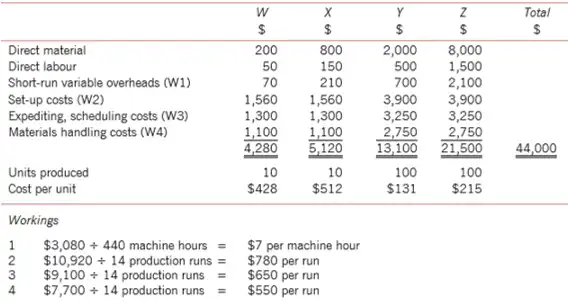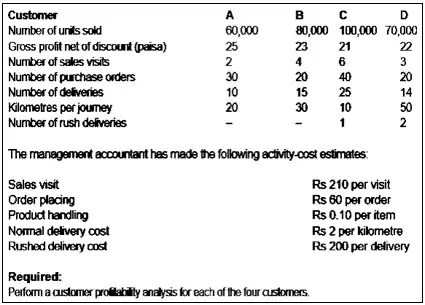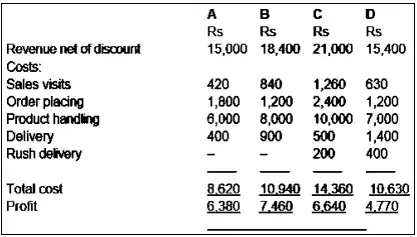- Cost planning
- Cost Analysis
- Cost management Techniques
- Externally oriented Cost Management Techniques
- Relevant costs
- Short term decisions
- Risk and Uncertainty
- Linear programming – graphical method
- Linear programming the simplex method
- Multi Product CVP Analysis
- Pricing decisions and Pricing strategies
- Budgetary Control
- Performance Evaluation
- Measuring performance in divisionalised businesses
- Transfer pricing
Activity based costing (ABC)
Activity based costing (ABC) has been developed as an alternative costing system to traditional overhead absorption costing. ABC was developed to improve the cost allocation process as traditional techniques assumed that costs were only driven by volume.
Definition – Activity Based Costing (ABC) is ‘An approach to the costing and monitoring of activities which involves tracing resource consumption and costing final outputs. Resources are assigned to activities and activities to cost objects based on consumption estimates. It uses cost drivers to attach activity costs to outputs.
Production overheads are not necessarily driven by volume, therefore allocation using traditional methods is not necessarily meaningful. With ABC, multiple overhead absorption rates (OARs) are calculated based on the different activities that cause the costs to change.
Cost drivers and cost pools
A cost driver is a ‘factor influencing the level of cost. Examples of cost drivers:
- Set-up costs – Number of production runs
- Production scheduling – Number of production runs
- Inspection costs – Number of inspections or inspection hours
- Despatch costs – Number of customer orders delivered
All of the costs associated with a particular cost driver (for example production runs) would be grouped into cost pools.
Types of cost driver
- Resource cost driver – is a measure of the quantity of resources consumed by an activity. It is used to assign the cost of a resource to an activity or cost pool.
- Activity cost driver – is a measure of the frequency and intensity of demand placed on activities by cost objects. It is used to assign activity costs to cost objects.
In traditional absorption costing, overheads are first related to cost centres and then to cost objects (products). In ABC, overheads are first related to activities or grouped into cost pools (depending on the terminology preferred) and then related to the cost objects.
Like traditional absorption costing rates, ABC rates are calculated in advance, usually for a year ahead.
Stages in ABC calculations
- Group overheads into cost pools, according to how they are driven. This involves gathering overheads that are caused by the same activity into one group and is done by means of resource cost drivers.
- Identify the cost drivers for each activity
- Calculate a cost per unit of cost driver (Cost driver rate = total cost of activity / Cost driver)
- Absorb activity costs into production based on the usage of cost drivers.

*ABC traces the appropriate amount of input to each product. However, it is important to realise that although ABC should be a more accurate way of relating overheads to products, it is not a perfect system and product costs could still be inaccurate, as ABC is based on a number of assumptions.
A summary of benefits and limitations
Benefits
- Provides more accurate product-line costings particularly where non-volume-related overheads are significant and a diverse product line is manufactured.
- Is flexible enough to analyse costs by cost objects other than products such as processes, areas of managerial responsibility and customers.
- Provides a reliable indication of long-run variable product cost which is particularly relevant to managerial decision making at a strategic level.
- Provides meaningful financial (periodic cost driver rates) and non-financial (periodic cost driver volumes) measures which are relevant for cost management and performance assessment at an operational level.
- Aids identification and understanding of cost behaviour and thus has the potential to improve cost estimation.
- Provides a more logical, acceptable and comprehensible basis for costing work.
Limitations
- Little evidence to date that ABC improves corporate profitability.
- ABC information is historic and internally orientated and therefore lacks direct relevance for future strategic decisions.
- Practical problems such as cost driver selection.Its novelty is questionable. It may be viewed as simply a rigorous application of conventional costing procedures.
Many of ABC’s supporters claim that it can assist with decision making because it provides accurate and reliable cost information. ABC establishes a long-run product cost and because it provides data that can be used to evaluate different business possibilities and opportunities, it is particularly suited for the types of decision such as:
- Pricing
- Make or buy decisions
- Promoting or discontinuing products or parts of the business
- Developing and designing changed products
* An ABC cost is an average cost, but it is not always a true cost because some costs, such as depreciation, are usually arbitrarily allocated to products. An ABC cost is therefore not a relevant cost for all decisions.
ABC and long-term decisions
ABC is particularly suited for long-term and strategic decisions (such as long-run pricing, capacity management and product mix decisions) for a number of reasons.
- It assumes all costs are variable in relation to product choice or production-level decisions.
- It has strategic relevance because it allows for a full understanding of activities and their resource consumption.
- Short-run changes in consumption do not translate into changes in spending (as real cash savings or expenditure are not made/incurred in the short run).
Activity based management (ABM)
The cost management version of ABC.
Definition – ‘System of management which uses activity-based cost information for a variety of purposes including cost reduction, cost modelling and customer profitability analysis.’
ABM is simply using the information derived from an ABC analysis for cost management. ABM seeks to classify each activity within a process as a value-added or non-value-added activity.
Non-value-added activities are unnecessary and represent waste. The aim should be to eliminate them.
Two questions can be used to assess whether an activity adds value.
- Would an external customer encourage the organisation to do more of the activity?
- Would the organisation be more likely to achieve its goals by performing the activity?
If both answers are yes, the activity adds value.
ABM acts as an ‘umbrella’ for a number of techniques – such as customer profitability analysis (CPA). It uses the information generated by ABC to control or reduce cost drivers and also to reduce overheads.
ABM focuses on activities within a process, decision making and planning relative to those activities and the need for continuous improvement of all organisational activity. Management and staff must determine which activities are critical to success and decide how these are to be clearly defined across all functions.
Everyone must co-operate in defining:
- cost pools;
- cost drivers;
- key performance indicators.
Outputs from the ABM information system
Organisations that are designing and implementing ABM will find there are five basic information outputs:
- The cost of activities and business processes – the basic output of the ABM system must be to provide relevant cost information about what a business does. Instead of reporting what money is spent for and by whom, costs are assigned to activities.
- The cost of non-value-added activities – Identification of these wasteful activities is invaluable to management as it provides a crucial focal point for management.
- Activity based performance measures – Knowing the total cost of an activity is insufficient to measure activity performance. Activity measures of quality, cycle time, productivity and customer service may also be required to judge performance. Measuring the performance of activities provides a scorecard to report how well improvement efforts are working and is an integral part of continuous improvement.
- Accurate product/service cost – costs must be accurately determined.
- Cost drivers – With this information it is possible to understand and manage these activity levels
ABM can be used in assessing strategic decisions such as:
- whether to continue with a particular activity;
- how cost structures measure up to those of competitors;
- how changes in activities and components affect the suppliers and value chain.
ABM and employee empowerment take a critical step forward beyond ABC by recognising the contribution that people make as the key resource in any organisation’s success:
- It nurtures good communication and team work.
- It develops quality decision making.
- It leads to quality control and continuous improvement.
*ABM will not reduce costs; it will only help the manager understand costs better.
Implementing ABM
- Get the support of senior management.
- Know what ABM can achieve and what information you want from the system.
- Involve people in the field.
- Do not underestimate the need to manage the change process.
Distribution Channel Profitability
This looks at distribution channel profitability and why it is so important to manage these channels. It is linked to ABC and ABM. Distribution channel are in simple terms the means of transacting customers. Companies may transact with their customers through direct channel e.g. sales team, telephone, shops, internet or through indirect channels e.g. retailers, wholesalers, resellers and agents.
The channel a company selects is therefore a critical driver to business profitability. Regardless of whether a company’s channels are direct or indirect they should always consider the ultimate needs of the customer and therefore use the channel to ensure that those needs are satisfied.
Key aspects that the company need to consider in relation to their distribution channels include:
- access to the customer base
- brand awareness
- competitiveness, achieving sales and market targets
- speed of payment, customer retention rates and most importantly of all profitability
In companies it is just as important to cost channels as it is to cost products and customers. Different channels will differ in profitability.
Approaches to determining distribution channel profitability
Traditional approach
Product costs are allocated to distribution channels based on standard costs and the product mix sold through the channel, whereas, Sales, general and administrative costs are typically allocated to distribution channels on the basis of sales volume or net revenue for each channel.
*The approach also obviously has all the disadvantages associated with the traditional approach to product costing.
The ABC approach
Material costs and activity costs are allocated direct to products to produce product-related costs, which are then allocated to distribution channels on the basis of the mix of products sold in each channel.
This approach, which carries with it all the advantages of ABC, should result in more accurate information.
The main disadvantage to this approach is that the allocation is based on the assumption that all costs are driven by the production of particular products and hence must be allocated to products. For most organisations, however, the products they produce is just one of a range of cost drivers.
A refined ABC approach
This approach is based on the assumption that costs are driven not only by products produced, but by the customers served and the channels through which the products are offered.
*In conclusion, Distribution Channel Profitability used to determine the relative profitability of different distribution channels.
Activity based profitability analysis
Activity based profitability analysis can be linked to ABC techniques. By comparing the costs of products, customers and distribution channels with revenues, a tier of contribution levels can be established by applying the concept of the activity-based cost hierarchy.
The activity based analysis therefore assigns the costs to the appropriate level in the hierarchy (depending on whether a cost is incurred in relation to an activity that supports a product, product line/customer/distribution channel) and then aggregates the costs down the hierarchy to determine contribution margins by product, product line, customer and distribution channel.
Direct Product Profitability (DPP)
As traditional absorption costing, which normally uses labour hours as a basis for absorption, is rarely suitable for service and retail organisations other methods had to be devised. One relatively new way of spreading overheads in retail organisations, which is used in the grocery trade in particular, is direct product profitability (DPP).
Directly-attributable costs are grouped and are deducted from the gross margin to determine the product’s Direct product profit (DPP).
The benefits of DPP may be summarised as:
- Better cost analysis;
- Better pricing decisions;
- Better management of store and warehouse space;
- The rationalisation of product ranges;
- Better merchandising decisions.
Pareto Analysis
Pareto analysis simply aims to identify the most significant areas within one aspect of the business, thus allowing management to focus on and control these most important areas.
The 80/20 rule as it is known is often illustrated by drawing a component percentage bar chart. The 80/20 rule states that for example, the majority of a firm’s profit or revenue may be generated by a small percentage of total number of customers/product lines/divisions.
Procedure
- The first step is to rearrange the products in descending order of contribution
- Calculate the cumulative contribution.
- Turn this into a cumulative percentage.
- Draw a diagram to illustrate the principle
The term ‘Pareto diagram’ usually refers to a histogram or frequency chart on product quality.
The position of the products with most contributions needs protecting, perhaps through careful attention to branding and promotion. The other products require investigation to see whether their contribution can be improved through increased prices, reduced costs or increased volumes.
Customer Profitability Analysis (CPA)
Customers use some activities but not all, and different groups of customers have different activity profiles. Different customers or groups of customers differ in their profitability. This is a relatively new technique that ABC makes possible because it creates cost pools for activities.
Service organisations such as a bank or a hotel in particular need to cost customers. A bank’s activities for a customer will include the following types of activities:
- Withdrawal of cash;
- Unauthorised overdraft;
- Request for a statement;
- Stopping a cheque;
- Returning a cheque because of insufficient funds.
Different customers or categories of customers will each use different amounts of these activities and so customer profitability profiles can be built up, and customers can be charged according to the cost to serve them.
Example
Cruise Ltd sells a single product, the TopG. The selling price to its four main customers is different because of trade discounts offered.
The data below concerns individual customer requirements:

Solution

